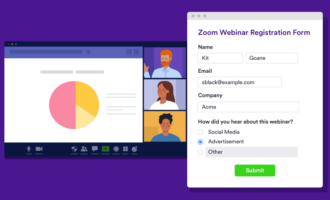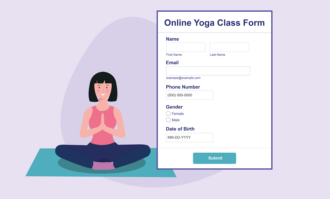Maintaining connectivity is crucial to a team’s success, especially as more businesses are transitioning to long-term or permanent remote work models.
Working remotely has traditionally meant that employees don’t get much face time with each other, but many companies have responded to that issue by adding videoconferencing options to their communication toolkits, giving team members more options for keeping in contact.
The two most popular videoconferencing platforms are Google Meet and Zoom. Both can host anywhere from two to hundreds of participants, and they offer free basic options as well as multiple paid business plans. But when you’re looking at Google Meet vs Zoom, there are some differences that might sway your decision.
Let’s break down some key comparison points to determine whether Google Meet or Zoom will be right for your business.
Pro Tip
Collect appointment bookings and turn them into Zoom meetings automatically with Jotform, the best Google Forms alternative.
Google Meet vs Zoom: The features
As far as features go, Google Meet and Zoom are pretty similar. Both platforms offer high quality HD video with scheduling capabilities, screen sharing, gallery layouts, background filters, and chat functions. And they’re constantly rolling out new and upgraded features — all within their free versions.
Plus, Zoom’s free plan allows local call recordings, breakout rooms, and waiting rooms, while Google Meet’s free plan allows for automatic closed captioning. (Zoom is working on implementing a similar accessibility feature for free users, which it calls “Live Transcription,” with an expected fall 2021 rollout.)
Google Meet’s free version allows anyone with a Google account to invite up to 100 participants to a 60-minute video call or to host a one-on-one call for up to 24 hours. Zoom’s free version allows anyone with a Zoom account to invite up to 100 participants to a 40-minute call, and it caps one-on-one calls at 30 hours.
Google Meet vs Zoom: Paid plans
Google Meet and Zoom offer tiered paid plans for businesses, which allow for longer video calls, a greater number of participants, and more. Google’s business plans, which include the entire Google Workspace, are priced between $6 and $18 per user, per month, while Zoom’s plans are priced between $15.99 and $26.99 per license, per month. Both companies also offer custom enterprise plans.
Google’s Business Plus plan allow up to 500 participants to join any video call, and calls can last up to 24 hours. Standard plans and above offer features such as call recording, breakout rooms, hand raising, and polls as well as additional support options.
With Google Workspace, your Google Meet will automatically integrate into your entire work system, which means your plan will include a custom business Gmail account, additional storage in Drive, team messaging with Chat, and a cohesive Calendar system.
Zoom’s business plans allow up to 300 participants to join any video call, and the calls have a time limit of 30 hours. With the Large Meetings add-on, which starts at an additional $50 per month, businesses can schedule meetings with up to 1,000 participants. Paid plans with Zoom also come with live support options as well as polling, streaming, and closed-captioning features.
Google Meet vs Zoom: The platforms
Google Meet allows you to start or join a call from your web browser, and you’ll never need to download additional software to your computer in order to access Google Meet’s full capabilities.
Zoom, on the other hand, does require an app download in order to schedule or begin a call, but it allows you to join a call directly from your browser. The only time this might cause an issue is if your employees need admin access to download and update apps on their work computers. So Zoom’s download requirement could make things a bit trickier for your IT department.
Both Google Meet and Zoom also offer mobile apps, allowing for video calls on the go.
Google Meet vs Zoom: Security
Whenever we conduct business over the internet, security is a top concern. Luckily, Google and Zoom understand that. Both companies use a series of measures to keep your data and virtual space safe from intruders, and they’re constantly enhancing security and privacy capabilities.
Google is an established global leader in internet security, often setting the privacy standards we’ve come to expect from our online experience. Zoom, as a newer company that experienced fast growth throughout the COVID-19 pandemic, has had to react to various security concerns, but it’s still considered largely safe for business (and personal) use.
Both Google Meet and Zoom calls are encrypted, meaning all data transmitted over your video calls on either platform will be inaccessible to outsiders.
To protect your individual calls, Google Meet and Zoom both offer two-factor authentication, unique meeting access codes, and the ability to mute or remove disruptive or unwelcome participants.
When you’re comparing Google Meet vs Zoom, it’s important to note that no matter which one you choose, you’re going to benefit from a high-quality product.
There’s a reason why the two options are seen as top competitors in the videoconferencing space: As more companies have adjusted their business models to accommodate remote work, both Google and Zoom have invested in the technology behind their videoconferencing platforms to provide secure and effective virtual meeting spaces.
So there’s really no definitive best choice — maybe just a better pick, depending on your needs.































Send Comment: